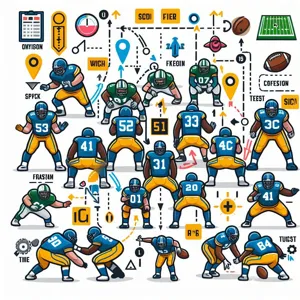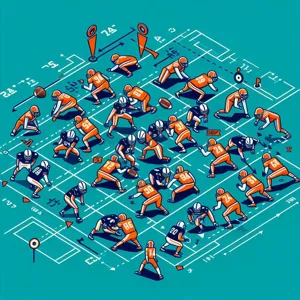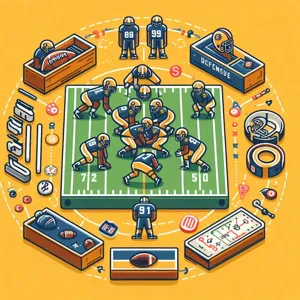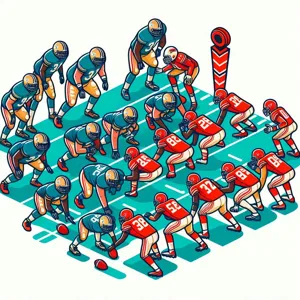American football is a sport steeped in strategy and teamwork, where every down can be a game-changer.
At the heart of this dynamic game lies the intricate world of defensive schemes, a realm where coaches and players craft plans to thwart their opponents and seize victory. From the aggressive blitz of a 4-3 defense to the nuanced coverage strategies of the Tampa 2, understanding these defensive formations is essential for any football enthusiast eager to grasp the complexities of the game. In this blog post, we will embark on a deep dive into the various defensive schemes employed in American football, exploring their origins, key principles, and how they adapt to counter different offensive strategies. Whether you’re a seasoned fan or a newcomer eager to learn, this exploration of the playbook will illuminate the tactical brilliance that defines the defensive side of the game, showcasing how a well-executed scheme can turn the tide of a match and create unforgettable moments on the field.
1. Introduction to Defensive Schemes in American Football

Defensive schemes in American football are the backbone of a team’s strategy, serving as a crucial element in the battle for dominance on the field. As the saying goes, “Offense wins games, but defense wins championships,” and understanding the intricacies of defensive play can be the key to elevating a team’s performance.
At its core, a defensive scheme is designed to prevent the opposing team from advancing the ball and scoring points. This involves a complex interplay of player positioning, tactical formations, and play-calling, all of which are tailored to counteract the strengths and exploit the weaknesses of the offense. Coaches and coordinators meticulously study their opponents, crafting schemes that can shift mid-game depending on the flow of play and the strategies employed by the offense.
There are several foundational defensive schemes that teams may adopt, each with its own philosophy and tactical approach. The 4-3 defense, for instance, features four defensive linemen and three linebackers, providing a balanced and versatile setup that can effectively defend against both the run and the pass. Conversely, the 3-4 defense, which employs three defensive linemen and four linebackers, offers greater flexibility in blitzing and coverage, allowing for a more dynamic and unpredictable defensive front.
In addition to these traditional formations, teams also explore zone and man-to-man coverage schemes, each presenting its own advantages and challenges. Zone coverage focuses on defending specific areas of the field, while man-to-man coverage relies on individual matchups, demanding high levels of skill and discipline from players.
As we delve deeper into the various defensive schemes employed in American football, we will explore the strategic nuances, historical evolution, and key players that have defined each approach. By understanding these elements, fans and aspiring players alike can gain a richer appreciation for the cerebral nature of football and the vital role that defense plays in achieving victory on the gridiron.
2. The Role of Defense in Football Strategy
In the intricate tapestry of American football, defense plays a pivotal role that extends far beyond merely preventing the opposing team from scoring. It serves as the backbone of a comprehensive game strategy, influencing the flow of the game and dictating the tempo in which offenses can operate. A well-executed defensive scheme can unravel even the most sophisticated offenses, turning the tide of a match and demoralizing opponents before they even set foot on the field.
At its core, the defense’s primary objective is to disrupt the offensive play, and it does so through a combination of formation, personnel, and strategy. Defenses are often categorized into various schemes, including the 4-3, 3-4, and nickel formations, each designed to counter specific offensive strategies. For instance, a 4-3 defense, which features four down linemen and three linebackers, is particularly effective against the run, providing a robust front capable of shutting down ground attacks. In contrast, a 3-4 defense, which relies on three down linemen and four linebackers, excels in flexibility and can confuse quarterbacks with its ability to disguise blitzes and coverages.
Moreover, the defense is not just about personnel; it is also about a mindset. Defensive players must possess a keen sense of anticipation and awareness, as they often need to react to the offense’s movements in real-time. This requires extensive film study and an understanding of the opponent’s tendencies, enabling defenders to predict plays before they unfold. Communication is also vital; defenders must work in unison, executing complex schemes that require seamless coordination among players.
The role of defense extends beyond just stopping the offense; it can also create opportunities for the team to score. Turnovers—interceptions and fumble recoveries—can shift momentum dramatically, often leading to points on the board for the defensive team. A defensive touchdown not only adds points to the score but also can energize the team and its fanbase, creating a ripple effect of enthusiasm that can be felt throughout the stadium.
In essence, the defense in football is a multifaceted entity that requires strategy, skill, and a deep understanding of the game. It’s a critical component that can dictate the overall success of a team, and as the game evolves, so too do defensive schemes, adapting to counter the ever-changing landscape of offensive tactics. Embracing the complexities of defensive play not only enhances a team’s competitive edge but also enriches the overall spectacle of American football, making it a thrilling game to watch and analyze.
3. Overview of Common Defensive Formations

When it comes to American football, the defensive formation is the backbone of a team’s strategy, serving as the initial line of defense against the opposing offense. Understanding the various common defensive formations can provide valuable insights into how teams adapt to different game situations and opponent tendencies. Here, we’ll explore some of the most prevalent defensive formations, each tailored to counter specific offensive strategies while maximizing the strengths of the defense.
### 3-4 Defense
One of the most popular formations in modern football, the 3-4 defense employs three defensive linemen and four linebackers. This setup allows for greater flexibility in defensive schemes, as the extra linebackers can be used to blitz, cover receivers, or plug gaps against the run. The 3-4 is particularly effective against teams that utilize a heavy ground game, as the additional linebackers can quickly fill running lanes.
### 4-3 Defense
In contrast, the 4-3 defense utilizes four down linemen and three linebackers. This classic formation provides a balanced approach, allowing for strong run defense while maintaining the ability to put pressure on the quarterback. The 4-3 is often favored by teams that prioritize a stout defensive line, as it creates one-on-one matchups that can be exploited by powerful pass rushers.
### Nickel Formation
As the game has evolved, so too has the need for more versatile defensive personnel. The nickel formation introduces a fifth defensive back into the lineup, making it particularly effective against passing-heavy offenses. Typically used on obvious passing downs, the nickel defense enables teams to better cover multiple receivers while still having enough support against the run. This formation is crucial in today’s game, where spread offenses often put pressure on traditional defensive setups.
### Dime Formation
Taking the concept of the nickel formation a step further, the dime formation features six defensive backs. This scheme is most commonly used in long-yardage situations where the likelihood of a pass is high. By sacrificing a linebacker for an additional defensive back, teams can enhance their pass coverage and respond better to complex route combinations. However, the trade-off is a potential vulnerability against the run, making this formation a calculated risk.
### Tampa 2
The Tampa 2 is a zone coverage scheme that has gained popularity due to its effectiveness against both the run and the pass. In this formation, two safeties patrol deep zones while the cornerbacks cover short to intermediate routes. The middle linebacker is responsible for the zone between the two safeties, providing a buffer against deep passes. This formation emphasizes teamwork and communication, as defensive players must work in unison to cover their zones effectively.
### Conclusion
Each of these defensive formations serves a unique purpose and can be employed based on the strengths of the defense and the tendencies of the opposing offense. Mastery of these formations allows defensive coordinators to craft game plans that not only thwart offensive schemes but also create opportunities for turnovers and big plays. As the game continues to evolve, so too will the strategies behind these formations, making the study of defensive schemes a fascinating and ever-relevant aspect of American football.
4. Understanding the 4-3 Defense
The 4-3 defense is one of the most recognized and widely utilized schemes in American football, serving as a foundational strategy for many teams across various levels of play. At its core, the 4-3 defense consists of four down linemen and three linebackers, creating a robust frontline capable of both defending against the run and applying pressure on the quarterback. This alignment provides a solid balance between strength and speed, making it adaptable to a range of offensive plays.
In a typical 4-3 setup, the defensive line features two defensive ends and two defensive tackles. The defensive ends, positioned outside, are typically faster and more agile, tasked with containing outside runs and pressuring the quarterback from the flanks. The defensive tackles, lined up inside, are generally larger and stronger, focusing on clogging up the middle of the offensive line and stopping the run at its source.
Behind the line, the three linebackers play a crucial role in the 4-3 scheme. The middle linebacker, often regarded as the leader of the defense, is responsible for reading the offense and making key tackles, while the outside linebackers, positioned on either side, have the dual duty of supporting the run defense and providing coverage against the pass. This versatility allows the 4-3 defense to effectively respond to various offensive strategies, whether it’s a power run game or a quick passing attack.
One of the significant advantages of the 4-3 defense is its ability to generate pressure on the quarterback. With four down linemen, defensive coordinators can design blitz packages that utilize linebackers or defensive backs, creating confusion for the offense. The scheme also allows for flexibility in coverage schemes, enabling the team to adjust to different offensive formations by shifting players and disguising their intentions.
However, like any defensive scheme, the 4-3 defense has its drawbacks. Teams that rely heavily on a power running game may find success against it, especially if the defensive tackles are unable to hold their ground. Additionally, if the defensive line struggles to generate pressure, the secondary can be left vulnerable to deep passes.
In summary, the 4-3 defense is a strategic choice that emphasizes balance, versatility, and aggressive play. Understanding its nuances allows players and coaches to optimize their approach, making it a cornerstone of defensive football that continues to evolve with the game. Whether you’re a seasoned fan or new to the sport, grasping the fundamentals of the 4-3 defense is key to appreciating the intricate chess match that unfolds on the gridiron.
5. Exploring the 3-4 Defense

### 5. Exploring the 3-4 Defense
The 3-4 defense is a strategic formation that has gained popularity in the realm of American football for its versatility and adaptability on the field. Unlike the traditional 4-3 defense, which features four down linemen and three linebackers, the 3-4 defense employs three defensive linemen and four linebackers, creating a dynamic approach to both pass rushing and run stopping.
At first glance, the 3-4 may seem less robust in the trenches due to its reduced number of linemen. However, this scheme compensates with its emphasis on speed and athleticism among the linebackers. These players are tasked with various roles, from blitzing the quarterback to dropping back into coverage, making them crucial to the defense’s overall effectiveness. The flexibility of the 3-4 allows teams to disguise their intentions, keeping offenses guessing and creating opportunities for disruptive plays.
Key to the success of the 3-4 defense is the “nose tackle,” a player who lines up directly over the center. This position demands strength and agility, as the nose tackle must engage multiple blockers while freeing up the linebackers to make plays. The two defensive ends in a 3-4 scheme also have unique responsibilities, often tasked with controlling the edges and providing support against running plays.
One of the most intriguing aspects of the 3-4 defense is its ability to create mismatches. With four linebackers on the field, teams can employ a variety of coverage schemes, allowing them to adapt to the strengths and weaknesses of the opposing offense. This flexibility can be particularly effective against high-powered passing attacks, as the defense can switch between zone and man coverage, keeping quarterbacks on their toes.
Additionally, the 3-4 defense encourages aggressive play-calling. Coordinators can mix in blitzes from different angles, utilizing linebackers and even defensive backs, to apply pressure on the offense. This unpredictability can lead to turnovers and sacks, turning the tides of a game in an instant.
As we delve deeper into the playbook, understanding the nuances of the 3-4 defense equips fans and players alike with a greater appreciation for the strategic depth of American football. Whether it’s the choreography of a linebacker blitz or the tactical decisions made by a defensive coordinator, the 3-4 defense is an embodiment of the chess-like nature of the sport, where every move counts and adaptability is key to success on the gridiron.
6. The Nickel and Dime Packages Explained
In the intricate world of American football, defensive strategies are as critical to a team’s success as their offensive counterparts. Among the arsenal of defensive formations, the Nickel and Dime packages stand out for their ability to adapt to the evolving landscape of the game, particularly in response to the rise of spread offenses and passing-heavy schemes.
**Nickel Package**
The Nickel package typically employs five defensive backs instead of the usual four. This additional defensive back, often referred to as the “nickelback,” is crucial for countering teams that utilize multiple wide receivers. By substituting a linebacker for an extra defensive back, defenses can enhance their coverage capabilities without sacrificing too much against the run. This flexibility allows teams to effectively match up against three or more wide receiver sets, ensuring they have the speed and agility needed to cover elusive receivers while still maintaining a solid run defense. The Nickel package is often seen in obvious passing situations, such as third downs, where the offense is less likely to run the ball.
**Dime Package**
Taking it a step further, the Dime package introduces a sixth defensive back into the mix. This scheme is typically deployed in obvious long-yardage situations where the offense is expected to pass. By removing another linebacker (or sometimes a defensive lineman), the Dime package allows for even greater emphasis on pass coverage. This formation is particularly effective against teams that rely heavily on short, quick passes or deep routes, as it provides a wealth of coverage options, allowing defenses to flood the field with more players who can react to the ball. The downside, however, is that the Dime package can leave defenses vulnerable to the run. This is where the strategic chess match comes into play, as offensive coordinators may try to exploit this weakness by running the ball against a lighter defensive front.
In summary, the Nickel and Dime packages are vital components of a modern defensive playbook, showcasing the delicate balance between stopping the pass and maintaining run defense. Coaches and players must continuously analyze the strengths and weaknesses of their opponents, adjusting their strategies in real time to ensure they stay one step ahead. Whether it’s the quick adjustment of bringing in a nickelback or the bold decision to go with a dime formation, these schemes highlight the dynamic nature of defensive football and the importance of versatility in today’s game.
7. Key Players and Their Roles in Defensive Schemes

In the intricate tapestry of American football, defensive schemes are only as effective as the players executing them. Understanding the key roles within these schemes is essential for grasping how defenses function and adapt to various offensive strategies.
**1. Defensive Linemen:** Often regarded as the frontline soldiers, defensive linemen are crucial for disrupting the opposing offense right at the snap. Their primary objective is to penetrate the offensive line and pressure the quarterback or stop the run. These players need to possess a combination of strength, quickness, and agility to shed blockers and make tackles. In schemes like the 4-3 defense, the defensive tackles often focus on clogging running lanes, while the defensive ends are tasked with containing the edge and rushing the passer.
**2. Linebackers:** The linebackers serve as the backbone of the defense, acting as the primary playmakers and communicators. They have the unique responsibility of defending against both the run and the pass, making them versatile players in any defensive scheme. In a 3-4 defense, for instance, outside linebackers must be adept at rushing the passer while also dropping back into coverage. Their ability to read plays quickly and react accordingly is vital for successful defensive execution.
**3. Defensive Backs:** The last line of defense, defensive backs, including cornerbacks and safeties, are tasked with covering receivers and preventing big plays. Cornerbacks primarily focus on one-on-one matchups with wide receivers, utilizing their speed and agility to stay with their targets. Safeties, on the other hand, often play deeper in the field, providing help over the top and acting as a safety net against deep passes. In zone coverage schemes, their ability to recognize routes and react quickly can make or break a defensive stand.
**4. Hybrid Players:** As the game evolves, the introduction of hybrid defensive players adds another layer of complexity to defensive schemes. These players, such as safety-linebacker hybrids, offer unparalleled versatility, allowing coaches to adapt their defensive strategies on the fly. They can fill multiple roles, whether it’s blitzing the quarterback, dropping back into coverage, or covering running backs and tight ends.
In sum, each position within a defensive scheme has its unique responsibilities and skill sets that contribute to the overall effectiveness of the defense. Recognizing the strengths and roles of key players not only enhances our understanding of defensive strategies but also highlights the intricate dance that occurs on the field during each play. As the game continues to evolve, so too will the roles of these players, making the study of defensive schemes an ever-fascinating aspect of American football.
8. How Defensive Schemes Adapt to Offensive Strategies
In the ever-evolving landscape of American football, defensive schemes must be as dynamic and adaptable as the offenses they aim to thwart. The relationship between offense and defense is akin to a high-stakes chess match, where each move is meticulously calculated and countered. As offensive strategies become more innovative, defensive coordinators are forced to think outside the box, continuously refining their approaches to maintain an edge on the field.
Defensive schemes often begin with a foundational alignment, such as the 4-3 or 3-4 formations, but within these structures lies a wealth of tactical flexibility. For instance, when facing a pass-heavy offense that utilizes quick slants and screens, a defensive team might shift to a more aggressive nickel package, deploying additional defensive backs to bolster pass coverage. This not only enhances their ability to counter quick throws but also allows them to maintain coverage against slot receivers who are increasingly pivotal in modern offenses.
Moreover, the rise of mobile quarterbacks has prompted defenses to implement spy techniques, assigning a dedicated linebacker or safety to shadow the quarterback. This tactic is essential for containing dual-threat QBs who can extend plays with their legs, as it forces them to make quick decisions under pressure while minimizing their ability to scramble for yardage.
Another critical aspect of how defensive schemes adapt is through the use of disguise and deception. Coordinators often deploy pre-snap movements, shifting players and formations to confuse the opposing offense. By presenting a façade of a different alignment or coverage scheme, they can bait quarterbacks into making mistakes or force them into unfavorable matchups. This psychological warfare can be the difference between a touchdown and a turnover, showcasing the intricate dance between offensive ingenuity and defensive resilience.
In essence, the adaptability of defensive schemes to offensive strategies is vital for success in American football. As offensive teams continue to innovate, the best defenses are those that can pivot quickly, employing a blend of strategic adjustments and psychological tactics to keep their opponents on their toes. This ongoing battle of wits not only defines the outcome of games but also shapes the very evolution of the sport itself.
9. The Importance of Communication on Defense
In the high-stakes world of American football, where split-second decisions can determine the outcome of a game, communication on the defensive side of the ball is not just important—it’s essential. Defensive players must operate as a cohesive unit, often in response to the unpredictable nature of the opposing offense. If one player misses a crucial signal or fails to relay information, it can lead to catastrophic breakdowns and, quite literally, open the door for an opponent’s big play.
At the heart of effective communication on defense is the role of the defensive captain, typically the middle linebacker or a safety, who serves as the vocal leader. This player is responsible for calling the plays, adjusting formations based on the offensive setup, and ensuring that everyone understands their assignments. They must have a deep understanding of both their own team’s strategies and the tendencies of the opposing offense. This requires quick thinking and an ability to analyze situations on the fly.
Moreover, communication is not limited to verbal cues. Defensive players must also develop a language of gestures and visual signals, especially in loud stadiums where shouting is futile. This non-verbal communication allows teammates to remain aware of their responsibilities even amidst the chaos of a game. For instance, a simple hand signal can indicate a shift in coverage or a change in the blitz scheme, allowing the defense to adapt seamlessly to the offensive play.
Practices play a crucial role in honing this communication. Teams often dedicate time to drill scenarios that emphasize the importance of talking through assignments and reacting to changes on the field. This repetition helps to build trust among players, as they learn to rely on one another to execute their responsibilities effectively.
Ultimately, the effectiveness of a defense can often be traced back to how well its players communicate. Teams that excel in this area tend to create turnovers, limit big plays, and maintain the upper hand against even the most formidable offenses. In the intense arena of American football, where every detail matters, clear and consistent communication can be the difference between victory and defeat.
10. Analyzing Blitzing Techniques and Their Effectiveness
Blitzing is one of the most dynamic and aggressive strategies in American football, designed to disrupt the offensive rhythm and create pressure on the quarterback. At its core, a blitz involves sending additional defenders—usually linebackers or defensive backs—beyond the standard rushers to overwhelm the offensive line and force hurried decisions. But not all blitzes are created equal; their effectiveness hinges on a blend of timing, deception, and execution.
To analyze blitzing techniques, we must first consider the various types of blitzes employed. The most common include the zone blitz, where defenders drop into coverage while a lineman rushes, and the overload blitz, which sends more rushers to one side of the offensive line, creating a numerical advantage. Each technique requires precise coordination and communication among defenders to ensure that gaps are covered and that the quarterback’s escape routes are minimized.
The effectiveness of a blitz can be gauged by several factors. First, the element of surprise is crucial; a well-timed blitz can catch an offense off-guard, leading to hurried throws or even turnovers. However, predictable blitz patterns can be easily exploited by savvy quarterbacks who can read defenses and make quick adjustments. Additionally, the offensive line’s ability to recognize and adapt to a blitz can dramatically influence its success. Teams with strong offensive lines can often neutralize a blitz by executing quick throws or employing effective screen plays, turning the defensive aggressiveness against itself.
Moreover, the psychological aspect of blitzing cannot be underestimated. Consistent blitzing can instill a sense of fear in quarterbacks, potentially leading to indecision and mistakes. Coaches often use this to their advantage, mixing blitzes with zone coverage to keep opposing offenses guessing. By creating uncertainty, defenses can capitalize on the slightest misstep, turning a well-planned play into a chaotic scramble.
In conclusion, while blitzing can be a highly effective strategy to disrupt offensive plays, it requires a keen understanding of timing, execution, and the ability to adapt. Teams must evaluate their personnel, game situations, and the specific strengths and weaknesses of their opponents to develop a successful blitzing scheme. As we explore deeper into the playbook, it becomes evident that mastering blitzing techniques is not merely about sending extra players but about crafting a tactical masterpiece that can shift the momentum of the game.
11. The Evolution of Defensive Schemes Over the Years
The evolution of defensive schemes in American football is a fascinating journey that reflects the game’s dynamic nature and the strategic minds behind its play. From the early days of football, where defenses primarily relied on brute strength and basic formations, to the sophisticated, layered schemes we see today, the development of defensive strategies has been driven by innovation, necessity, and a relentless pursuit of competitive advantage.
In the early 20th century, defenses were fairly simple, often utilizing the 7-2-2 alignment, which favored a strong front but left the secondary vulnerable. As the game progressed and offensive strategies became more complex, particularly with the rise of the forward pass, defenses had to adapt. The introduction of the 4-3 defense in the 1950s was a pivotal moment; it provided a balanced approach that allowed for both run stopping and pass coverage, laying the foundation for modern defensive schemes.
The 1970s ushered in the era of the “Steel Curtain” defense, epitomized by the Pittsburgh Steelers, which showcased the effectiveness of a dominant front seven coupled with a versatile secondary. This period also saw the emergence of zone coverage concepts, which allowed defenders to cover specific areas of the field rather than focusing solely on individual matchups. The adaptation of these strategies reflected a deeper understanding of offensive patterns and a commitment to thwarting the increasingly intricate passing games.
Fast forward to the 21st century, and we find a league dominated by high-octane offenses that challenge defenses in unprecedented ways. This has led to the adoption of hybrid schemes that blend elements from various traditional formations. Defensive coordinators now employ strategies like the 3-4 defense, which emphasizes versatility and allows for more creativity in player positioning. The “Nickel” and “Dime” packages, designed to counteract the spread offense, have become staples, allowing teams to put extra defensive backs on the field to better handle multiple receiver sets.
Moreover, the integration of analytics into the game has revolutionized how teams approach defensive schemes. Coaches can now analyze vast amounts of data to determine tendencies, exploit weaknesses, and tailor their strategies to not just the opponent, but also to the conditions of the game. This data-driven approach has led to more dynamic, adaptable defenses that can shift between various schemes in real-time, making them more unpredictable and difficult to prepare for.
As we look to the future, the evolution of defensive schemes will undoubtedly continue to unfold, shaped by advancements in technology, player skill sets, and the ever-changing landscape of offensive strategies. The cat-and-mouse game between offense and defense remains at the heart of football, and those who can anticipate and adapt will thrive in this exhilarating sport. Whether it’s through innovative formations, strategic game planning, or the integration of cutting-edge analytics, the journey of defensive schemes is a testament to the creativity and ingenuity that make American football such a captivating spectacle.
12. Case Studies: Successful Defensive Teams and Their Schemes
In the world of American football, few elements are as critical to a team’s success as its defensive scheme. To truly understand how these strategies come to life on the field, we can look at several case studies of teams that have excelled in defensive play. These examples not only highlight the effectiveness of various schemes but also illustrate how adjustments and innovations can lead to championship success.
One of the standout teams in recent history is the 2015 Denver Broncos, who showcased the prowess of the “Tampa 2” defense. Under the guidance of defensive coordinator Wade Phillips, the Broncos combined aggressive pass rush tactics with a disciplined secondary. Their strategy involved utilizing two deep safeties to cover the back end while linebackers patrolled the intermediate zones. This approach allowed the Broncos to stifle opposing quarterbacks, leading them to a Super Bowl victory that season. Key players like Von Miller and Aqib Talib were instrumental in executing this scheme, demonstrating how individual talent can elevate a defensive strategy.
Another notable example is the 2000 Baltimore Ravens, whose defense is often lauded as one of the greatest in NFL history. Implementing a “46 Defense” scheme, the Ravens employed a unique alignment that overloaded the line of scrimmage, creating chaos for opposing offenses. With players like Ray Lewis and Ed Reed at the helm, they executed a blend of man-to-man coverage and heavy blitzing that overwhelmed quarterbacks and stifled the run game. Their success culminated in a Super Bowl championship, illustrating how a steadfast and aggressive defensive scheme can dominate the league.
Lastly, the New England Patriots’ 2003 and 2004 squads exemplified the effectiveness of the “3-4 Defense.” Under the innovative leadership of Bill Belichick, the Patriots utilized a mix of zone coverage and strategic blitzing, allowing for versatile player roles that kept offenses guessing. The ability to switch between man and zone coverage, along with the seamless communication among defensive players, transformed their unit into a formidable force. This adaptability not only led to back-to-back Super Bowl victories but also solidified their legacy as a defensive powerhouse.
These case studies highlight that successful defensive teams often share common traits: adaptability, communication, and the ability to leverage player strengths within their schemes. By analyzing their strategies, we can glean valuable insights into how to build an effective defense that can withstand the pressures of the game and keep opponents at bay. As we continue to explore defensive schemes, these examples serve as a testament to the impact that a well-executed plan can have on achieving greatness in American football.
13. The Future of Defensive Strategies in Football
As the game of American football continues to evolve, so too do the defensive strategies employed by teams at all levels. The future of defensive schemes is poised to be shaped by several key trends that reflect advancements in technology, player analytics, and the ever-changing landscape of offensive tactics.
One of the most significant shifts on the horizon is the integration of data analytics into defensive game planning. Coaches are increasingly relying on sophisticated algorithms and metrics to analyze opponents’ tendencies, which allows them to devise tailored strategies that counter specific offensive plays. This data-driven approach not only helps in identifying weaknesses but also enables teams to adapt in real-time during games, optimizing their responses to the dynamic nature of the field.
Moreover, the rise of hybrid players—those who can fluidly transition between positions—will influence defensive formations. Expect to see more versatile athletes who can play multiple roles within a single defensive series, creating confusion for opposing offenses and making it harder for quarterbacks to read the defense. This adaptability can lead to unpredictable blitz packages and coverage schemes that keep offenses guessing.
Additionally, the increasing focus on speed and agility will continue to redefine defensive lineups. As offenses prioritize quicker, more explosive plays, defenses will need to match that pace by employing lighter, faster players capable of covering ground swiftly. This shift could see a resurgence of smaller, more agile linebackers and defensive backs who excel in coverage, as well as the utilization of zone schemes designed to capitalize on speed while minimizing gaps.
The emergence of artificial intelligence in game analysis is another factor that could revolutionize defensive strategies. Coaches and analysts can now leverage AI to simulate various game scenarios, refining their defensive approaches based on predictive modeling. This means that future defenses could be more prepared than ever to counteract the rapid innovations in offensive playcalling.
Ultimately, the future of defensive strategies in football will be a balance of tradition and innovation. While foundational principles like teamwork, communication, and discipline remain crucial, the infusion of technology, analytics, and player versatility promises to usher in a new era of defensive football. As teams adapt to these changes, fans can look forward to even more thrilling matchups where the chess match between offensive and defensive schemes takes center stage.
14. Tips for Coaches: Implementing Effective Defensive Schemes
Implementing effective defensive schemes is a critical aspect of any football coach’s strategy. As the game evolves, so too must your approach to defense, blending traditional techniques with innovative tactics to outsmart opposing offenses. Here are some essential tips for coaches looking to fortify their defensive schemes:
1. **Know Your Personnel**: Understanding your players’ strengths and weaknesses is paramount. A defensive scheme should be tailored to fit the skill sets of your athletes. For instance, if you have a speedy linebacker, consider employing a blitz-heavy strategy that capitalizes on their agility. Conversely, if you have a strong defensive line, a more traditional 4-3 setup may serve your team better.
2. **Emphasize Communication**: Defense requires seamless coordination among players. Establish a culture of communication on the field, where players are encouraged to call out formations, alert one another to shifts, and execute adjustments on the fly. This can be enhanced through regular drills that simulate game scenarios, ensuring everyone understands their role within the scheme.
3. **Study Opponents**: Knowledge is power in football. Analyze game tapes of your opponents to identify their tendencies, favorite plays, and preferred formations. This insight allows you to anticipate their moves and adjust your defensive strategy accordingly. Developing a game plan that exploits their weaknesses can give your team a significant edge.
4. **Versatility is Key**: Flexibility in your defensive schemes can confuse offenses and create mismatches. Consider implementing hybrid roles for players, allowing them to switch between positions depending on the situation. This unpredictability can disrupt an offensive rhythm and force them to adjust on the fly.
5. **Practice Situational Defense**: Football games are often decided in critical moments. Use practice time to simulate high-pressure situations, such as defending against a two-minute drill or a third-and-long scenario. teaching your players to stay composed and execute under pressure is vital for success.
6. **Focus on Fundamentals**: No defensive scheme can succeed without solid fundamentals. Dedicate time to honing basic skills such as tackling, positioning, and reading the quarterback. A well-drilled defense that executes fundamental techniques will consistently outperform a team that relies solely on complex schemes.
7. **Instill a Defensive Mindset**: Cultivating a fierce, tenacious defensive attitude among your players can transform your team’s performance. Encourage a mentality of aggression and resilience, where players see themselves as the backbone of the team. This psychological edge can translate into more intense play on the field.
By integrating these tips into your coaching strategy, you can create defensive schemes that not only respond effectively to opponents but also inspire confidence and performance from your players. The key to a successful defense is a combination of preparation, adaptability, and a commitment to excellence—principles that will resonate throughout your program and lead to greater success on the gridiron.
15. Conclusion: The Balance Between Defense and Offense in Football
In the high-stakes environment of American football, the age-old debate of defense versus offense continues to captivate fans, coaches, and players alike. As we draw our exploration of defensive schemes to a close, it becomes clear that the most effective teams are those that strike a delicate balance between these two pivotal aspects of the game. A formidable defense can be the backbone of a championship team, providing the necessary security and stability that allows the offense to flourish. Conversely, a dynamic offense can light up the scoreboard and create momentum, but without a strong defensive foundation, it risks exposing itself to vulnerability.
The interplay between defense and offense is akin to a finely tuned orchestra, where each section must harmonize to create a cohesive performance. A brilliant defensive scheme can thwart even the most talented offensive lineups, forcing them into mistakes and creating opportunities for turnovers. Meanwhile, an offense that understands how to exploit defensive weaknesses can turn the tide of a game in an instant.
This balance is not merely a matter of strategy; it reflects the philosophy of the entire team. Great coaches recognize the importance of fostering synergy between their defensive and offensive units, ensuring that they communicate effectively and support each other on the field. As the game continues to evolve, with offenses becoming increasingly innovative and dynamic, so too must defensive strategies adapt and respond.
In conclusion, the synergy between defense and offense is not just a tactical consideration; it is the essence of football itself. Teams that prioritize this balance are often the ones that find the most success, demonstrating that while defense may win championships, it is the collaboration between both units that ultimately drives a team toward victory. As we move forward in this ever-evolving sport, the ability to adapt and harmonize these elements will remain key to achieving greatness on the gridiron.
In conclusion, our exploration of defensive schemes in American football has unveiled the intricate strategies and tactics that shape the game. From the relentless pressure of the blitz to the disciplined coverage of zone defenses, each scheme plays a pivotal role in dictating the flow of the match. As you reflect on the insights we’ve shared, remember that understanding these defensive strategies not only enriches your appreciation of the sport but also enhances your ability to analyze and enjoy every play on the field. Whether you’re a passionate fan or a budding coach, applying this knowledge can deepen your connection to the game and prepare you for many thrilling discussions with fellow enthusiasts. So gather your friends, dive into a game, and watch as you spot these defensive maneuvers in action, armed with a new perspective that will surely elevate your football experience.






